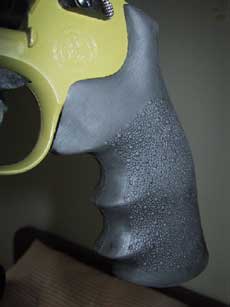Tanaka
M629 Review |
|
 Vital
Stats Vital
StatsOwner: 888
Total
Length: 11.5
inch
Inner
Barrel: Approx.
5-3/4 inch
Weight: 830
g (with
barrel weights & fully loaded)
Shot
Capacity: 14
Power: 380
FPS w/ .30g & green gas
Effective Range: 30-50 feet |
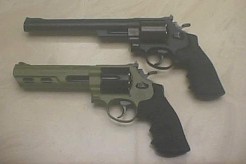 The
Performance Center is an excellent choice if you want to sample
a Tanaka revolver but not quite sure which one to get. The one being
reviewed here is the NATO green model, mechanically identical to
the other versions of the Performance Center save for a few minor
changes. The
Performance Center is an excellent choice if you want to sample
a Tanaka revolver but not quite sure which one to get. The one being
reviewed here is the NATO green model, mechanically identical to
the other versions of the Performance Center save for a few minor
changes. Ugh!
"Pea-soup" colored pistol... Many of you find the NATO green color
appalling. I admit I quickly overlooked this model and leaned more
toward purchasing the silver or midnight blue version. However,
the problem with the midnight blue is that it very easily scratches,
not something I would recommend for skirmishing use. And silver...well
its silver, stands out too much since I wanted an effective pistol
for field use.
So what the heck, NATO green it is then... |
|
Unlike
my .44 magnum, the NATO green field strips as shown in less than
a minute. This is very handy if you like to keep your guns in good
working order, and want easy access to vital parts for routine maintenance.
The inner barrel is brass that is just painted black; same diameter bore as all the other Tanaka revlovers. Because the inner barrel is not as long as my M29, the shot consistency is not as good. Nevertheless, .30g bb's will fly quite straight once you break in the hop-up notch and stabilize the inner barrel. |
|
Being a NBB, there are no moving parts to worry about that take added stress from higher powered gas. However, this doesnt mean the gun is immune to the effects. Although I cant be certain that green gas will dry up the seals & o-rings , its always better to be safer than sorry... |
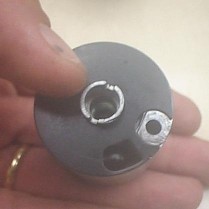 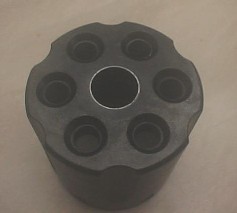 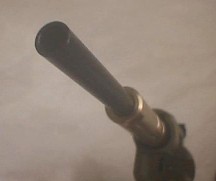 |
The black plate comes right off; actually... it pops right off along with the bb feeder spring as soon as you remove the guts from the casing. Not to worry though, its pretty easy to put back together once you get the hang of it. |
|
The picture on the right is the front part of the cylinder. (A) is where the valve is located. Its kind of a pain to remove so I will wait until I get my high flow valve. Keep this part lightly lubricated, if it remains dry, then you have a chance of the plunger o-ring coming undone or possibly even crack. (B) is
where the gas is released from. Try not to lube this part otherwise
you will get too much silicone oil on the hop-up notch. The
same goes for the black plastic bb feeder, try to keep it dry. |
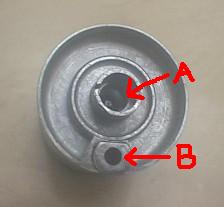  |
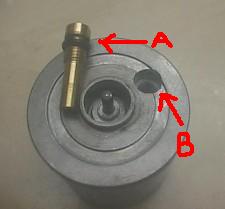 |
To the left is the rear of the cylinder. (A) is the fill valve. Be sure to keep the o-ring here well lubricated. (B) is where it screws into. The black rod sticking out is the strike pin. You may want to lube this if you feel it to be neccessary. |
| (A) holds the cylinder together. As a precaution, I recommend you teflon tape the threading. If you somehow strip this, the cylinder will no longer hold the gas. |  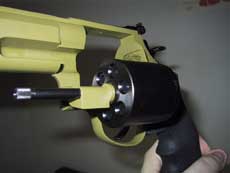 |
|
See the screw (A) ? By turning clockwise, you increase tension on the leaf spring, turning counter-clockwise will reduce it. When the leaf spring has a higher tension, the hammer will strike the firing pin harder, giving the gun a bit more velocity ^_^ Simple enough yes? This is very handy if you want to fine tune the bb trajectory off the fixed hop-up or to just simply increase/decrease the power. |

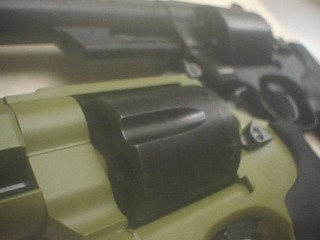 The
NATO green model comes with the "un-fluted" cylinder. Interesting
thing about this is that the function is much smoother than the
standard magnum cylinder. I noticed that shots dont misfeed when
rapid fired, and half cocking the gun will enable the cylinder
to "spin" twice as fast and twice as long. Since I use my .44
magnum more, I swapped the outer cylinder casing between the two
models as shown above.
The
NATO green model comes with the "un-fluted" cylinder. Interesting
thing about this is that the function is much smoother than the
standard magnum cylinder. I noticed that shots dont misfeed when
rapid fired, and half cocking the gun will enable the cylinder
to "spin" twice as fast and twice as long. Since I use my .44
magnum more, I swapped the outer cylinder casing between the two
models as shown above. 
 Maintenance:
If you
bought a Tanaka revolver, chances are that you are using only green
gas.
Maintenance:
If you
bought a Tanaka revolver, chances are that you are using only green
gas.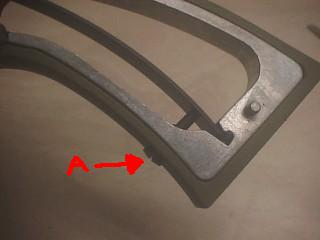 Tuning?
Tanaka
revolvers dont use the same striking system as other revolver makes.
Instead of using a small spring on a striker, Tanaka uses
the leaf spring to load the hammer just like the real steel.
Tuning?
Tanaka
revolvers dont use the same striking system as other revolver makes.
Instead of using a small spring on a striker, Tanaka uses
the leaf spring to load the hammer just like the real steel.